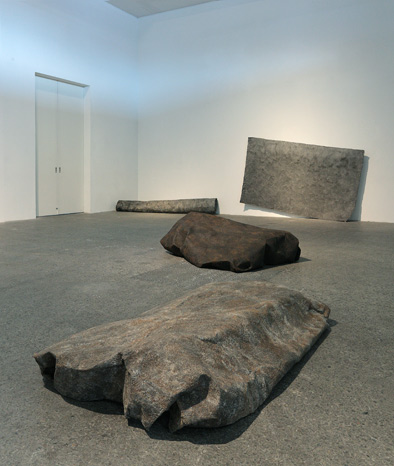‘WORKS‘

The Unique Experiments of Tomoda Taeko
Tatehata Akira (Director, National Museum of Art, Osaka/Art Critic)
Tomoda Taeko's paper work differs greatly from what is commonly expected of the material.
Paper is still seenas a support medium that is flexible and delicate, thin and flat, and used primarily for printing, writing or drawing.Even in more recent paper work, the emphasis tends to be on texture and lightness.
But Tomoda's work marks a complete departure from the paper tradition that has been cultivated over hundreds
of years. Hers is a rigid material that gives form to a decidedly three-dimensional space with a rough, stone-like
surface texture. One might say that Tomoda has drawn out the unexpected potential of paper with her unique
methods.
But is her work actually a "departure" from the original aspects of paper? Has Tomoda really deviated from its
basic concepts? Not necessarily. Rather, based on her own type of bold challenge, Tomoda brings out an aspectof the material
that has generally remained hidden to create a solid presence and dynamic form. In essence,
Tomoda has brought to light something that everyone else has overlooked: the charm of paper in its own right.
Tomoda makes her paper by hand with dissolved mulberry and wood pulp as raw materials.
And instead of using the popular technique of _nagashi-suki_, in which dissolved paper is drained by swinging the
mold from side to side, she places it on a flat area and allows it to dry naturally. As this process is repeated and layer after layer
is added, the paper attains the thickness of a board. Then, after it dries, mist is sprayed on the paper, allowing it to be shaped
into three dimensions. The unique texture, which might best be described as appealing more to
one's sense of touch than sight, arises out of this process which incorporates
an artificial operation with a period > of natural drying in which the
paper is exposed to the sun and the wind.
The resultant plates, with a variety of shapes, have the air of a relief in and of themselves, but in many cases,
Tomoda combines a number of them to create a large-scale installation. No matter how rigid it might be, paper
is paper, and as it can be hung on the wall, suspended in the air or folded up on the floor, it is easier to shape
than any other material. Tomoda makes the most of the special characteristics of her material to produce a space
that is unaffected and imbued with a fantastic sense of floating.
While there is an unmistakable charm to the texture and structure of the work, one should also note the strength
of the color. Almost all of the plates are either a monochromatic black or brown, but the color wasn't added
later. It came about naturally by mixing India ink, iron oxide or persimmon tannin into the original mixture of
raw materials. The reason the space in these rich installations inspires a sense of silent tension is that a depth,
represented by the ground color, is integrated with the power of the texture.
In Tomoda's work, there is an assurance of thought regarding method and material along with an experimental
approach toward form. As an artist who has developed a world of unprecedented paper work, Tomoda Taeko is
once again deserving of special acclaim.
[Translated by Christopher Stephens]